In times of economic uncertainty, the Federal Reserve finds itself in the crosshairs of political influence and public expectation. A brighter jobs report, coupled with unpredictable inflation rates, forced the central bank to maintain its current interest rates, a decision spurred on by external pressures, particularly from figures like former President Donald Trump. The economy appears to be teetering, overwhelmed by various contradictions—rising inflation juxtaposed alongside signs of a strengthening job market. While Trump fervently argues that “NO INFLATION” warrants a reduction in rates to stimulate growth, the Fed’s chair, Jerome Powell, stands firm on the bank’s autonomy from political currents, prioritizing the integrity of monetary policy over the whims of Capitol Hill.
The challenge becomes particularly acute when one considers how tariffs imposed as part of Trump’s expansive trade policies impact inflation forecasts. These tariffs could inflate prices further, creating a conundrum where monetary easing becomes more complicated. The persistence of economic uncertainty is palpable, leading many economists to recognize that the consumers, the backbone of the economy, remain caught in the crossfire.
For Consumers, the Payoff Is Dismal
Consumers today are grappling with a dual threat: elevated borrowing costs and rising goods prices. Despite an apparent resilience in employment figures, rising prices drive a wedge between consumer wallets and available cash. According to Eugenio Aleman, chief economist at Raymond James, it’s the consumers who suffer the consequences of these macroeconomic decisions. With credit card debt and mortgage rates reaching unprecedented heights, it becomes more evident that the struggle to meet financial obligations is biting harder than ever.
The federal funds rate is critical in this landscape as it directly influences how banks price their loans and mortgages. Though borrowers may welcome the prospect of lower rates eventually, immediate relief is scant. With the market anticipating potential cuts in July, it remains to be seen how many consumers will benefit from reduced borrowing costs, especially when banks remain skittish about the overall economic environment.
The Dilemma of Credit Cards and Mortgages
Current trends in consumer lending reveal a concerning trend for those reliant on plastic for day-to-day expenses. Credit card rates, already hovering around a staggering 20%, remain high as banks attempt to mitigate risks amid economic turbulence. Institutions like LendingTree highlight the nervousness surrounding the economy, which leads to higher interest rates on credit products, further burdening consumers already pressed with escalating costs of living.
Moreover, mortgage rates, while tentatively declining, still present a barricade for potential home buyers. The average rate for a 30-year fixed mortgage is slightly down but still uncomfortably perched at 6.81%. While there’s a glimmer of hope for some alleviation, reports indicate that it may not be enough to reactivate a stagnant housing market. For aspiring homeowners, this presents not only a financial challenge but also a psychological one, as the perception of affordability continues to erode.
The Auto Loan Crisis in Full View
The automotive market tells a similar story of frustration and financial strain. Despite only a slight dip in auto loan rates, they remain high, exacerbated by the tariffs on imported vehicles that further inflate consumer costs. The cyclical nature of economic policies—particularly those from the previous administration—serves to keep consumers on edge as they wrestle with the psychology of spending amidst financial strain.
The current average rate on a five-year car loan appears manageable at 7.33%, yet the reality is that rising prices force consumers to stretch their budgets. The stark truth is that while the auto industry might show signs of movement, the costs associated with each transaction seem to just keep creeping up.
The Student Loan Landscape
For students and recent graduates, the landscape is equally daunting. While federal student loan rates remain fixed, the repercussions of previous policy decisions continue to echo in their present financial realities. During this cycle, rising costs and fewer federal assistance opportunities contribute to a growing sense of anxiety among educational borrowers. The 6.53% rate for the upcoming school year highlights the conflicting pressures students face—certainly daunting when coupled with high living costs and job market volatility.
In times of economic unpredictability, many financial experts stress the importance of bolstering emergency savings while minimizing high-interest debt. It is a lesson underscored by the current state of consumer finance, urging individuals not only to remain vigilant but proactive in taking charge of their financial destinies in a landscape marred by inconsistency at every level.

